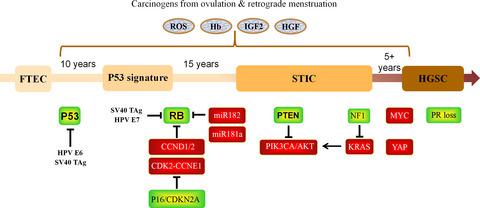当前位置:
X-MOL 学术
›
Cell Prolif.
›
论文详情
Our official English website, www.x-mol.net, welcomes your
feedback! (Note: you will need to create a separate account there.)
Cellular models of development of ovarian high‐grade serous carcinoma: A review of cell of origin and mechanisms of carcinogenesis
Cell Proliferation ( IF 5.9 ) Pub Date : 2021-03-25 , DOI: 10.1111/cpr.13029 Jie Mei, Huixiang Tian, Hsuan‐Shun Huang, Che‐Fang Hsu, Yuligh Liou, Nayiyuan Wu, Wei Zhang, Tang‐Yuan Chu
Cell Proliferation ( IF 5.9 ) Pub Date : 2021-03-25 , DOI: 10.1111/cpr.13029 Jie Mei, Huixiang Tian, Hsuan‐Shun Huang, Che‐Fang Hsu, Yuligh Liou, Nayiyuan Wu, Wei Zhang, Tang‐Yuan Chu

|
High‐grade serous carcinoma (HGSC) is the most common and malignant histological type of epithelial ovarian cancer, the origin of which remains controversial. Currently, the secretory epithelial cells of the fallopian tube are regarded as the main origin and the ovarian surface epithelial cells as a minor origin. In tubal epithelium, these cells acquire TP53 mutations and expand to a morphologically normal ‘p53 signature’ lesion, transform to serous tubal intraepithelial carcinoma and metastasize to the ovaries and peritoneum where they develop into HGSC. This shifting paradigm of the main cell of origin has revolutionarily changed the focus of HGSC research. Various cell lines have been derived from the two cellular origins by acquiring immortalization via overexpression of hTERT plus disruption of TP53 and the CDK4/RB pathway. Malignant transformation was achieved by adding canonical driver mutations (such as gain of CCNE1) revealed by The Cancer Genome Atlas or by noncanonical gain of YAP and miR181a. Alternatively, because of the extreme chromosomal instability, spontaneous transformation can be achieved by long passage of murine immortalized cells, whereas in humans, it requires ovulatory follicular fluid, containing regenerating growth factors to facilitate spontaneous transformation. These artificially and spontaneously transformed cell systems in both humans and mice have been widely used to discover carcinogens, oncogenic pathways and malignant behaviours in the development of HGSC. Here, we review the origin, aetiology and carcinogenic mechanism of HGSC and comprehensively summarize the cell models used to study this fatal cancer having multiple cells of origin and overt genomic instability.
中文翻译:

卵巢高级浆液性癌发展的细胞模型:起源细胞和致癌机制的综述。
高度浆液性癌(HGSC)是上皮性卵巢癌的最常见和恶性组织学类型,其起源仍存在争议。目前,输卵管的分泌上皮细胞被认为是主要来源,而卵巢表面上皮细胞被认为是次要来源。在输卵管上皮中,这些细胞获得TP53突变并扩展为形态正常的“ p53标记”病变,转化为浆液性输卵管上皮内癌,并转移至卵巢和腹膜,然后发展为HGSC。源头主细胞的这种转移范式革命性地改变了HGSC研究的重点。通过hTERT的过表达加上TP53的破坏和CDK4 / RB途径获得永生化,已从这两个细胞起源中衍生出各种细胞系。恶性转化是通过添加《癌症基因组图谱》揭示的规范性驱动程序突变(例如CCNE1的获得)或YAP和miR181a的非规范性获得而实现的。或者,由于极端的染色体不稳定,可以通过使鼠永生化细胞长时间通过来实现自发转化,而在人类中,它需要排卵的卵泡液,其中含有再生的生长因子以促进自发转化。这些在人和小鼠中人工和自发转化的细胞系统已被广泛用于发现HGSC的发展过程中的致癌物,致癌途径和恶性行为。在这里,我们回顾一下原点,
更新日期:2021-05-02
中文翻译:

卵巢高级浆液性癌发展的细胞模型:起源细胞和致癌机制的综述。
高度浆液性癌(HGSC)是上皮性卵巢癌的最常见和恶性组织学类型,其起源仍存在争议。目前,输卵管的分泌上皮细胞被认为是主要来源,而卵巢表面上皮细胞被认为是次要来源。在输卵管上皮中,这些细胞获得TP53突变并扩展为形态正常的“ p53标记”病变,转化为浆液性输卵管上皮内癌,并转移至卵巢和腹膜,然后发展为HGSC。源头主细胞的这种转移范式革命性地改变了HGSC研究的重点。通过hTERT的过表达加上TP53的破坏和CDK4 / RB途径获得永生化,已从这两个细胞起源中衍生出各种细胞系。恶性转化是通过添加《癌症基因组图谱》揭示的规范性驱动程序突变(例如CCNE1的获得)或YAP和miR181a的非规范性获得而实现的。或者,由于极端的染色体不稳定,可以通过使鼠永生化细胞长时间通过来实现自发转化,而在人类中,它需要排卵的卵泡液,其中含有再生的生长因子以促进自发转化。这些在人和小鼠中人工和自发转化的细胞系统已被广泛用于发现HGSC的发展过程中的致癌物,致癌途径和恶性行为。在这里,我们回顾一下原点,











































 京公网安备 11010802027423号
京公网安备 11010802027423号